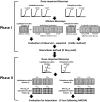A General Approach to Test for Interaction Among Mixtures of Insecticidal Proteins Which Target Different Orders of Insect Pests
- PMID: 28355479
- PMCID: PMC5416900
- DOI: 10.1093/jisesa/iex003
A General Approach to Test for Interaction Among Mixtures of Insecticidal Proteins Which Target Different Orders of Insect Pests
Erratum in
-
Corrigendum to: "A General Approach to Test for Interaction Among Mixtures of Insecticidal Proteins Which Target Different Orders of Insect Pests".J Insect Sci. 2018 Mar 1;18(2):22. doi: 10.1093/jisesa/iey004. J Insect Sci. 2018. PMID: 29718484 Free PMC article. No abstract available.
Abstract
A shift toward transgenic crops which produce combinations of insecticidal proteins has increased the interest (Syngenta Seeds, Inc., Minnetonka, MN) in studying the potential for interactions amongst those proteins. We present a general testing method which accommodates proteins with nonoverlapping spectrums of activity. Our sequential testing approach first investigates groups of the proteins with overlapping activity; e.g., proteins active against Lepidoptera or Coleoptera, respectively. The Colby method is used to test for interactions within each respective group. Subsequently, the mixture of proteins within each group is regarded as a single entity and tests for interactions between the groups (when combined) is conducted using analysis of variance. We illustrate the method using Cry1Ab, Vip3Aa20, and Cry1F (a mixture of proteins active against Lepidoptera), and mCry3A and eCry3.1Ab (a mixture of proteins active against Coleoptera). These insecticidal proteins are produced by Bt11 × MIR162 × TC1507 × MIR604 × 5307 maize. We detected no interactions between Cry1Ab, Vip3Aa20, and Cry1F in tests using larvae of two different lepidopteran species, and possible slight antagonism between mCry3A and eCry3.1Ab with a coleopteran test species. We detected no effect of (eCry3.1Ab + mCry3A) on the potency of (Cry1Ab + Vip3Aa20 + Cry1F) to lepidopteran larvae, and no effect of (Cry1Ab + Vip3Aa20 + Cry1F) on the potency of (mCry3A + eCry3.1Ab) to coleopteran larvae. We discuss implications of these results for characterization of Bt11 × MIR162 × TC1507 × MIR604 × 5307 maize, and the value of the method for characterizing other transgenic crops that produce several insecticidal proteins.
Keywords: Bacillus thuringiensis; Cry; stacked; synergism; trait.
© The Authors 2017. Published by Oxford University Press on behalf of Entomological Society of America.
Figures





Similar articles
-
Mortality impact of Bt transgenic maize roots expressing eCry3.1Ab, mCry3A, and eCry3.1Ab plus mCry3A on western corn rootworm larvae in the field.J Econ Entomol. 2011 Oct;104(5):1584-91. doi: 10.1603/ec11186. J Econ Entomol. 2011. PMID: 22066188
-
Lepidopteran-active variable-region sequence imparts coleopteran activity in eCry3.1Ab, an engineered Bacillus thuringiensis hybrid insecticidal protein.Appl Environ Microbiol. 2010 May;76(10):3082-8. doi: 10.1128/AEM.00155-10. Epub 2010 Mar 19. Appl Environ Microbiol. 2010. PMID: 20305020 Free PMC article.
-
Bt corn hybrids expressing mCry3A and eCry3.1Ab Proteins protect corn roots against western corn rootworm injury.Pest Manag Sci. 2023 Dec;79(12):4839-4846. doi: 10.1002/ps.7680. Epub 2023 Aug 7. Pest Manag Sci. 2023. PMID: 37489843
-
Insecticidal Activity of Bacillus thuringiensis Proteins Against Coleopteran Pests.Toxins (Basel). 2020 Jun 29;12(7):430. doi: 10.3390/toxins12070430. Toxins (Basel). 2020. PMID: 32610662 Free PMC article. Review.
-
Resistance to Bt maize by western corn rootworm: insights from the laboratory and the field.Curr Opin Insect Sci. 2016 Jun;15:111-5. doi: 10.1016/j.cois.2016.04.001. Epub 2016 Apr 13. Curr Opin Insect Sci. 2016. PMID: 27436740 Review.
Cited by
-
Meeting technical challenges for protein characterization and surrogate equivalence studies that resulted from insecticidal protein co-expression in maize event MZIR098.Transgenic Res. 2020 Feb;29(1):109-124. doi: 10.1007/s11248-019-00183-w. Epub 2019 Nov 28. Transgenic Res. 2020. PMID: 31781961 Free PMC article.
-
Assessing the Potential for Interaction in Insecticidal Activity Between MON 87751 × MON 87701 Produced by Conventional Breeding.Environ Entomol. 2019 Sep 30;48(5):1241-1248. doi: 10.1093/ee/nvz082. Environ Entomol. 2019. PMID: 31260530 Free PMC article.
-
Whole Genome Sequencing Analysis of Bacillus thuringiensis GR007 Reveals Multiple Pesticidal Protein Genes.Front Microbiol. 2021 Nov 2;12:758314. doi: 10.3389/fmicb.2021.758314. eCollection 2021. Front Microbiol. 2021. PMID: 34795652 Free PMC article.
-
Toxicity of Cry- and Vip3Aa-Class Proteins and Their Interactions against Spodoptera frugiperda (Lepidoptera: Noctuidae).Toxins (Basel). 2024 Apr 16;16(4):193. doi: 10.3390/toxins16040193. Toxins (Basel). 2024. PMID: 38668618 Free PMC article.
-
No Interactions of Stacked Bt Maize with the Non-target Aphid Rhopalosiphum padi and the Spider Mite Tetranychus urticae.Front Plant Sci. 2018 Feb 2;9:39. doi: 10.3389/fpls.2018.00039. eCollection 2018. Front Plant Sci. 2018. PMID: 29456543 Free PMC article.
References
-
- Abbott W. S. 1925. A method for computing the effectiveness of an insecticide. J. Econ. Entomol. 18: 265–267.
-
- Carrière Y., Crickmore N., Tabashnik B. E. 2015. Optimizing pyramided transgenic Bt crops for sustainable pest management. Nat. Biotech. 33: 161–168. - PubMed
-
- Chestukhina G. G., Kostina L. I., Mikhailova A. L., Tyurin S. A., Klepikova F. S., Stepanov V. M. 1982. The main features of Bacillus thuringiensis delta-endotoxin molecular structure. Arch. Microbiol. 132: 159–162.
-
- Colby S. R. 1967. Calculating synergistic and antagonistic response of herbicide combinations. Weeds 15: 20–22.
MeSH terms
Substances
LinkOut - more resources
Full Text Sources
Other Literature Sources
Molecular Biology Databases

